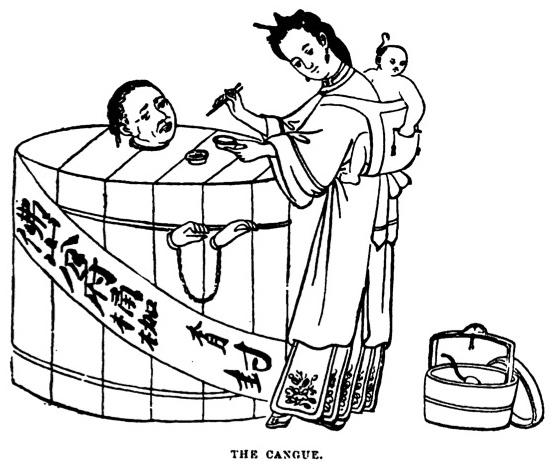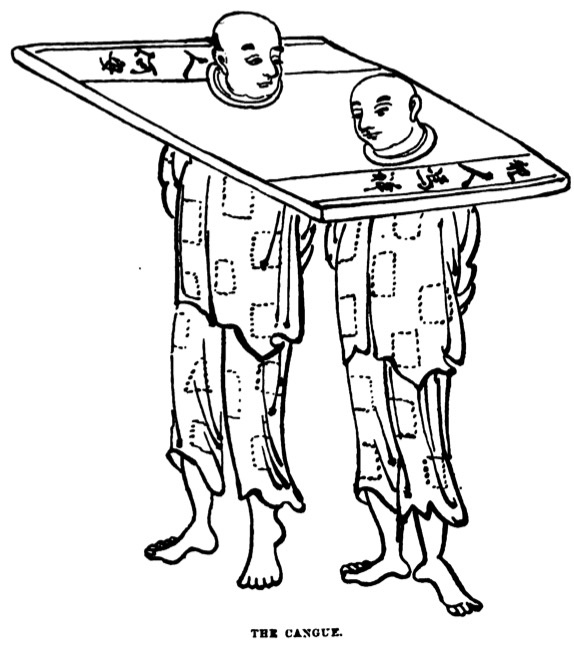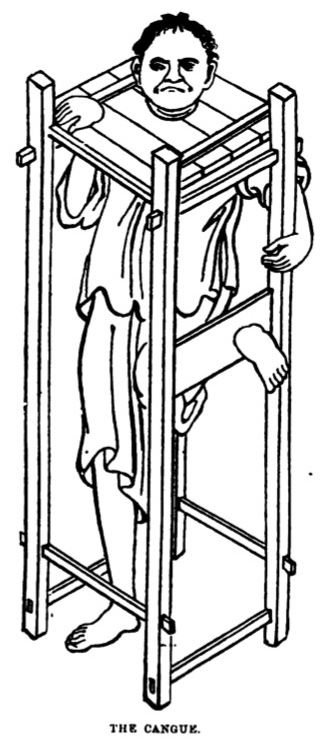The cangue (jia 枷, jiahao 枷號, jiajin 枷禁, jialing 枷令, jiashao 枷稍, jiashi 枷示) was a wooden board worn around the neck and the wrists by delinquents as a kind of punishment (see also penal tools). The cangue was to be worn in public and was thus a substantially humiliating punishment.
The character 圉 used in Shang-period 商 (17th-11th cent. BCE) oracle bone inscriptions might have been the word for an early form of the cangue.
During the Qin and Han 秦 (221-206 BCE) periods, the cangue still constisted of three parts, the "three wooden" (sanmu 三木) enclosures (xie 械). The term jia 枷 appeared during the Jin period 晉 (265-420). Through the ages, the jurisdictional system operated with detailed regulations for the size of cangues. During the Northern Dynasties period 北朝 (386~581), only rebels had to wear the heavy cangue (dajia 大枷). The Northern Qi dynasty 北齊 (550-577) applied it to criminals sentenced to penal servitude (tu 徒), while the Northern Zhou 北周 (557-581) enforced it also on criminals going into exile (liu 流) or execution. Another contemporary term for the cangue was chou 杻.
 |
 |
A barrel-shaped cangue (tongjia 桶枷) from the prefecture of Foshan 佛山, Guangdong, and a double-cangue inscribed with the names of the "criminals" (fanren 犯人). Source: Gray & Gregor 1878. |
|
The Song-period 宋 (960-1279) legal system discerned between various weights of cangues, ranging from 15 jin 斤 ("pounds", see weights and measures) to 25 jin. The cangue had a length of 5-6 chi 尺 "feet", and a width of 2.5-2.6 chi, the part around the neck was 1.4-1.6 chi wide, and the thickness was 3-4 cun 寸 "inches". The cangue of the Ming period 明 (1368-1644) was 5.5 chi long, and the part around the neck 1.5 chi.
Criminals sentenced to death wore a 35-jin cangue, those sentenced to penal servitude or exile one of 20 jin, while the small 15-jin cangue was reserved to those sentenced to blows with the heavy stick (zhang 杖).
The Ming system knew also extraordinary application of the cangue, in combination, for instance, with cutting off a foot, or long-term exhibition in public (youli 遊歷). The cangue was normally worn between 1 month and half a year, in rare cases for the rest of the life. Normally the Ming-period cangue had a weight of between 20 and 35 jin, but sizes of 120 or even 150 jin (c. 70 kg) are attested. Such cases would lead to death after several days. The collection Wenxing tiaoli 問刑條例 includes 53 articles for the use of the cangue.
Not only delinquents wore the cangue. There were cases that high officials were just humiliated by this sentence, like Wang Shizhong 王時中 (1466-1542), who was slandered by the eunuch Qiu Ju 丘聚 (see "Eight Tigers"). He was forced to wear the cangue and was displayed before the gate of the Censorate.
 |
A particularly cruel form of the cangue forcing the delinquent to stand. His right hand and left foot are separately enclosed between wooden boards. Source: Gray & Gregor 1878. |
The Qing dynasty 清 (1644-1911) took over the Ming system, but used the cangue often in combination with or as a surrogate for other punishments, like exile, penal military service (chongjun 充軍) or penal servitude. The heavy cangue had 70 jin, the light one 60. In 1740 the weight of the latter was reduced to 25 jin, but in the early 19th century again raised to 35 jin. In 1656, the Qing government decided that the cangue could also be applied to Manchu delinquents. Just as the part of the body in case of penal tattooing was determined by the type of crime, the period during which delinquents had to wear the cangue depended on the seriousness of the crime, or, if used in combination with exile, from the distance. Repeated crime required an extension of the period the cangue was to be worn. On the cangue, the reason for the punishment was written, so the public could learn about the delinquent and from the case.
In the very late Qing period, punishment with the cangue was abolished.